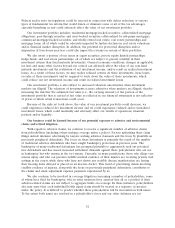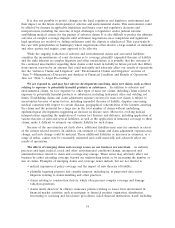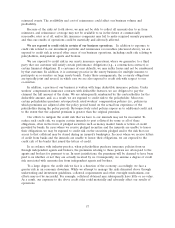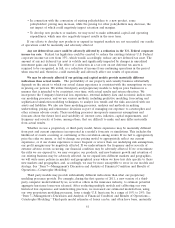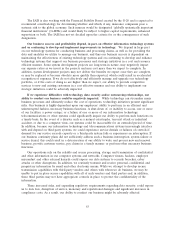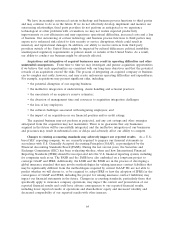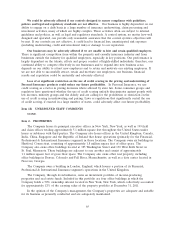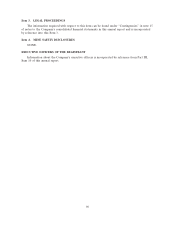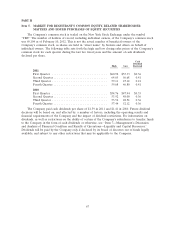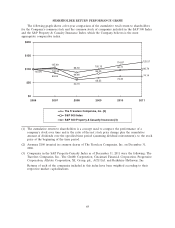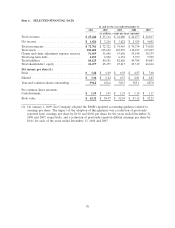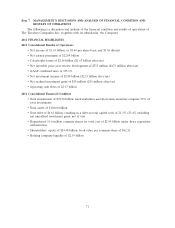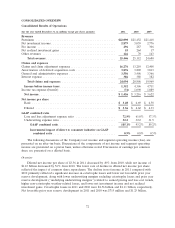Travelers 2011 Annual Report Download - page 74
Download and view the complete annual report
Please find page 74 of the 2011 Travelers annual report below. You can navigate through the pages in the report by either clicking on the pages listed below, or by using the keyword search tool below to find specific information within the annual report.different for similar events in comparison to our proprietary estimates. The differences between third-
party model estimates and our proprietary estimates are driven by the use of different data sets as well
as different assumptions and forecasts regarding the frequency and severity of events and claims arising
from the events. These assumptions and forecasts may be difficult to make and may differ materially
from actual results.
We are subject to a number of risks associated with our business outside the United States. We
conduct business outside the United States primarily in the United Kingdom, Canada and the Republic
of Ireland. In addition, we have commenced a joint venture in Brazil and may also explore
opportunities in other countries, including Latin American countries and other emerging markets such
as India and China.
While our business outside of the United States currently constitutes a relatively small portion of
our revenues, in conducting such business we are subject to a number of significant risks, particularly in
emerging economies. These risks include restrictions such as price controls, capital controls, currency
exchange limits, ownership limits and other restrictive or anti-competitive governmental actions, which
could have an adverse effect on our business and our reputation. Our investments outside the United
States may also subject us to currency risk and, in some markets, it may be difficult to effectively hedge
that risk. In addition, in some markets, we may invest as part of a joint venture with a local
counterparty. Because our governance rights may be limited, we may not have control over the ability
of the joint venture to make certain decisions and/or mitigate risks it faces, and significant
disagreements with a joint venture counterparty may adversely impact our investment. Investments
outside the United States also subject us to additional domestic and foreign laws and regulations,
including the Foreign Corrupt Practices Act and similar laws in other countries that prohibit the
making of improper payments to foreign officials. Although we have policies and controls in place that
are designed to ensure compliance with these laws, if those controls are ineffective and an employee or
intermediary fails to comply with applicable laws and regulations, we could suffer civil and criminal
penalties and our business and our reputation could be adversely affected. Some countries, particularly
emerging economies, have laws and regulations that lack clarity and, even with local expertise and
effective controls, it can be difficult to determine the exact requirements of, and potential liability
under, the local laws. For example, in some jurisdictions, including Brazil, parties to a joint venture
may, in some circumstances, have liability for some obligations of the venture and that liability may
extend beyond the capital invested. Failure to comply with local laws in a particular market may result
in substantial liability and could have a significant and negative effect not only on our business in that
market but also on our reputation generally.
New regulations outside of the U.S., including in the European Union, could adversely impact our
results of operations and limit our growth. Insurance laws or regulations that are adopted or
amended in jurisdictions outside the U.S. may be more restrictive than current laws or regulations and
may result in lower revenues and/or higher costs of compliance and thus could materially and adversely
affect our results of operations and limit our growth.
In particular, the European Union’s executive body, the European Commission, is implementing
new capital adequacy and risk management regulations called Solvency II that would apply to our
businesses in the European Union beginning as soon as the first quarter of 2013. Under Solvency II, it
is possible that the direct or indirect parent of a European Union subsidiary (including a U.S. parent
company) could be subject to certain Solvency II requirements if the regulator determines that the
subsidiary’s capital position is dependent on an affiliated or parent company and the affiliated or
parent company is not already subject to regulations deemed ‘‘equivalent’’ to Solvency II. In addition,
regulators in countries where we have operations are working with the International Association of
Insurance Supervisors (IAIS) (and in the U.S., with the NAIC) to consider changes to insurance
company supervision, including group supervision. While it is not yet known how these actions will
impact us, such regulation could result in increased costs of compliance, increased disclosure and less
flexibility in our capital management.
62


